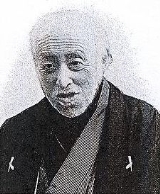
Niwa Nagakuni
Encyclopedia
Viscount ; was a Japanese daimyo
of the late Edo period who ruled Nihonmatsu han
and was famous for his leadership of the domain during the Boshin War
.
. On November 15, 1858 he succeeded to the family headship upon his father's retirement. He continued the joint coastal defense mission at Tomitsu (together with Aizu
han) begun by his father. In 1860, he sent forces for security duty in Kyoto, and was faced with a fire in his castle town, which seriously drained his resources. These expenses were compounded by the issues of the existing dire economic straits the domain was in following the Tenpo famines, as well as bureaucratic corruption. As a result, Nihonmatsu was utterly economically paralyzed by the end of the Edo period. However, it joined the Northern Confederation of Allied Domains
in 1868, and fought bravely against the forces of the Meiji Government. However, Nihonmatsu was defeated, and forced to give up 50,000 koku
of its holdings. Also, as per the government's conditions, Nagakuni retired, and his adopted son Niwa Nagahiro
(brother of the Yonezawa han daimyo Uesugi Mochinori
) succeeded him.
Nagakuni held the title of Sakyō-dayū (左京大夫) and the junior 4th court rank, lower grade (jū shi-i no ge 従四位下).
During the Meiji era, Nagakuni lived to see the Niwa clan recover some of its fortunes in society, receiving the title of viscount (子爵 shishaku). He died in 1904
Daimyo
is a generic term referring to the powerful territorial lords in pre-modern Japan who ruled most of the country from their vast, hereditary land holdings...
of the late Edo period who ruled Nihonmatsu han
Nihonmatsu Domain
The ' was a Japanese domain of the Edo Period. For the majority of its history it was ruled by the Niwa clan. The Nihonmatsu domain also took part in the fighting of the Boshin War, and was disbanded in 1871.-List of Daimyo:*Matsushita clan...
and was famous for his leadership of the domain during the Boshin War
Boshin War
The was a civil war in Japan, fought from 1868 to 1869 between forces of the ruling Tokugawa shogunate and those seeking to return political power to the imperial court....
.
Biography
Nagakuni, known in his childhood as Hōzō (保蔵) was born in Nihonmatsu on May 22, 1834, the 6th son of Niwa NagatomiNiwa Nagatomi
' was a Japanese daimyo of the late Edo period.-Biography:Nagatomi, known in his childhood as Kakuzō and later Bankichi , was born in his family's Edo residence in 1803. He was the eldest son of the previous daimyo, Niwa Nagaaki...
. On November 15, 1858 he succeeded to the family headship upon his father's retirement. He continued the joint coastal defense mission at Tomitsu (together with Aizu
Aizu
is an area comprising the westernmost third of Fukushima Prefecture in Japan. The principal city of the area is Aizuwakamatsu.During the Edo period, Aizu was a feudal domain known as and part of Mutsu Province.-History:...
han) begun by his father. In 1860, he sent forces for security duty in Kyoto, and was faced with a fire in his castle town, which seriously drained his resources. These expenses were compounded by the issues of the existing dire economic straits the domain was in following the Tenpo famines, as well as bureaucratic corruption. As a result, Nihonmatsu was utterly economically paralyzed by the end of the Edo period. However, it joined the Northern Confederation of Allied Domains
Ouetsu Reppan Domei
-External links:**...
in 1868, and fought bravely against the forces of the Meiji Government. However, Nihonmatsu was defeated, and forced to give up 50,000 koku
Koku
The is a Japanese unit of volume, equal to ten cubic shaku. In this definition, 3.5937 koku equal one cubic metre, i.e. 1 koku is approximately 278.3 litres. The koku was originally defined as a quantity of rice, historically defined as enough rice to feed one person for one year...
of its holdings. Also, as per the government's conditions, Nagakuni retired, and his adopted son Niwa Nagahiro
Niwa Nagahiro
Viscount ' was a Japanese daimyo of the early Meiji period who ruled Nihonmatsu han. The 9th son of Yonezawa lord Uesugi Narinori, he succeeded to the Nihonmatsu headship in 1868. Nihonmatsu had just lost in the Boshin War, and as one of the conditions for its surrender to the Imperial Japanese...
(brother of the Yonezawa han daimyo Uesugi Mochinori
Uesugi Mochinori
Count was a Japanese samurai of the late Edo period who served as the last daimyo of Yonezawa han in Dewa Province. In the Meiji era he became a government official and briefly served as governor of Okinawa Prefecture.- Biography :...
) succeeded him.
Nagakuni held the title of Sakyō-dayū (左京大夫) and the junior 4th court rank, lower grade (jū shi-i no ge 従四位下).
During the Meiji era, Nagakuni lived to see the Niwa clan recover some of its fortunes in society, receiving the title of viscount (子爵 shishaku). He died in 1904
Further reading
- Nihonmatsu-han shi 二本松藩史. Tokyo: Nihonmatsu-hanshi kankōkai 二本松藩史刊行会, 1926 (republished by Rekishi Toshosha 歴史図書社, 1973)
- Onodera Eikō 小野寺永幸. Boshin Nanboku Sensō to Tōhoku Seiken 戊辰南北戦争と東北政権. Sendai: Kita no Sha 北の杜, 2004.
- Sugeno Shigeru 菅野与. Ōshū Nihonmatsu-han nenpyō 奥州二本松藩年表. Aizu-Wakamatsu shi 会津若松市: Rekishi Shunjūsha 歴史春秋社, 2004.
External links
- Genealogical Information (in Japanese)
- Biography (in Japanese)

